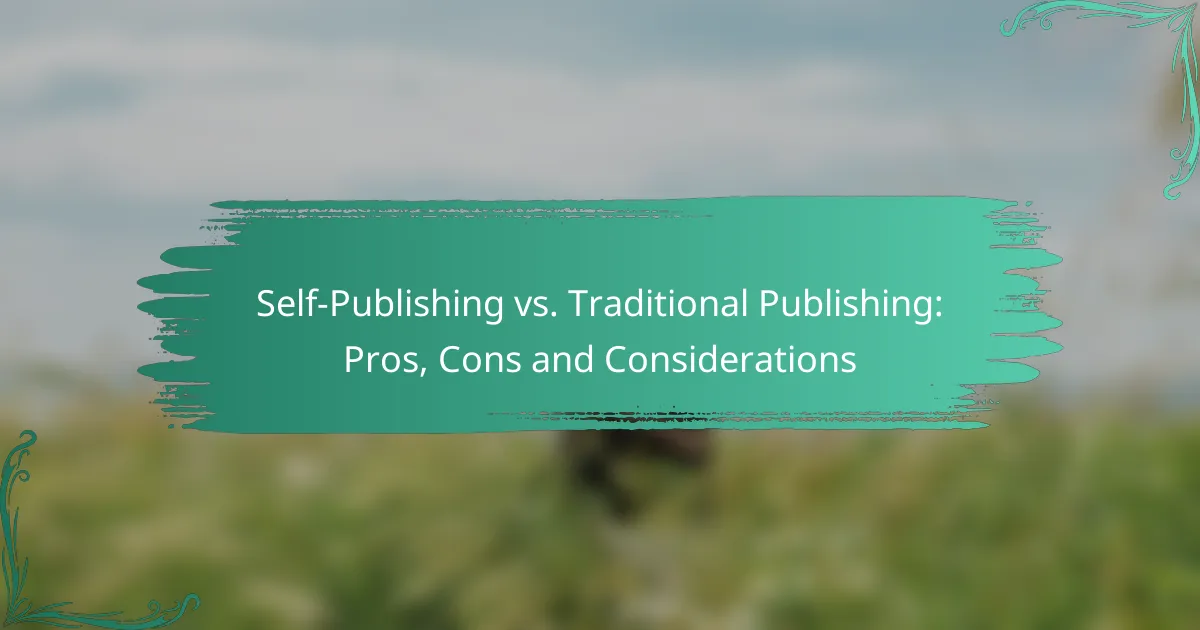The choice between self-publishing and traditional publishing is a pivotal decision for authors, each path offering distinct advantages and challenges. Self-publishing provides creative control and potentially higher earnings, while traditional publishing offers professional support and broader distribution. Understanding the pros and cons of each approach is essential for authors to make informed decisions about their publishing journey.
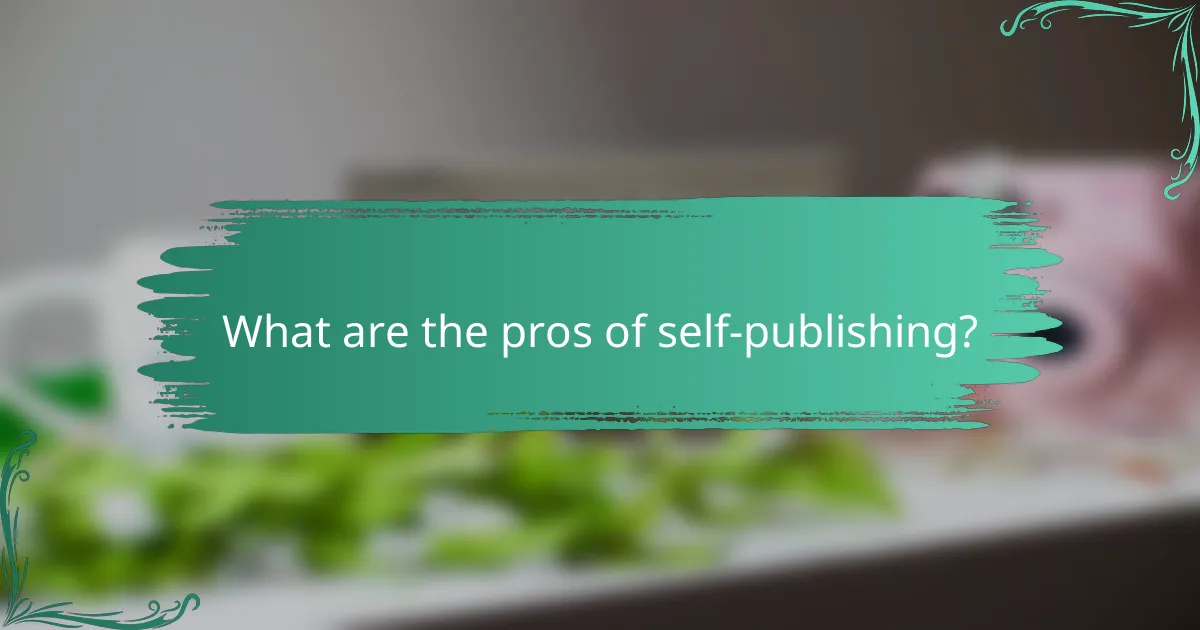
What are the pros of self-publishing?
Self-publishing offers authors significant advantages, including greater creative freedom, higher potential earnings, and a quicker route to market. These benefits make it an appealing option for many writers looking to maintain control over their work.
Creative control
Self-publishing allows authors to retain complete creative control over their content, cover design, and marketing strategies. This means you can make decisions that align with your vision without needing approval from a traditional publisher.
For example, you can choose your book’s title, cover art, and even the formatting style. This autonomy can be particularly beneficial for niche genres or unconventional topics that may not fit traditional publishing molds.
Higher royalties
Authors who self-publish typically earn higher royalties compared to traditional publishing, which often offers lower percentages. Self-publishing platforms can provide royalties ranging from 35% to 70% of the book’s sale price, depending on the platform and pricing strategy.
This higher earning potential means that successful self-published authors can significantly increase their income, especially if they market their books effectively and build a loyal readership.
Faster publication process
The self-publishing process is generally much faster than traditional publishing, which can take months or even years. Once your manuscript is ready, you can publish it within days or weeks, depending on your preparation and the platform you choose.
This speed allows authors to respond quickly to market trends or capitalize on timely topics, giving them a competitive edge in the publishing landscape.
Direct author-reader connection
Self-publishing enables authors to connect directly with their readers, fostering a more personal relationship. This direct interaction can lead to valuable feedback and a dedicated fan base, as authors can engage with readers through social media, newsletters, or book signings.
Building this connection can enhance marketing efforts, as satisfied readers are more likely to recommend your work and support future projects. This relationship is often harder to establish in traditional publishing, where communication is typically mediated by publishers.
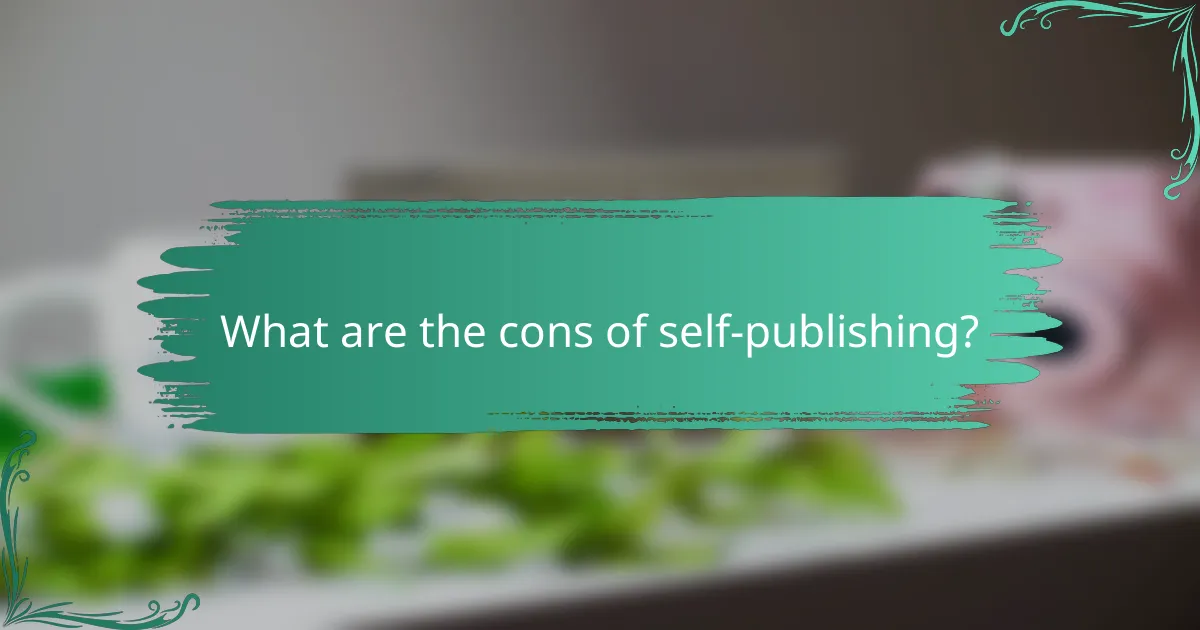
What are the cons of self-publishing?
Self-publishing offers authors greater control but comes with several drawbacks. Key cons include limited distribution, higher upfront costs, and the burden of marketing responsibilities.
Limited distribution
Self-published books often face challenges in reaching a wide audience. Unlike traditional publishers, who have established relationships with retailers and distributors, self-published authors may find their books available only through online platforms or niche bookstores.
This limited distribution can restrict visibility and sales potential. Authors should consider using print-on-demand services and online marketplaces to enhance their reach, but these options may still not match the extensive networks of traditional publishers.
Higher upfront costs
Self-publishing typically requires authors to invest their own money upfront. This includes expenses for editing, cover design, formatting, and marketing, which can collectively range from hundreds to thousands of dollars.
While traditional publishing often covers these costs, self-published authors must budget carefully to ensure their book meets professional standards. It’s crucial to weigh these costs against potential earnings and to seek out affordable services or resources.
Marketing responsibilities
In self-publishing, the author is solely responsible for marketing their book, which can be daunting. This includes creating a marketing plan, engaging with readers on social media, and organizing promotional events.
Many authors underestimate the time and effort required for effective marketing. To succeed, it’s advisable to develop a clear strategy, leverage online platforms, and consider collaborating with book bloggers or influencers to expand reach.
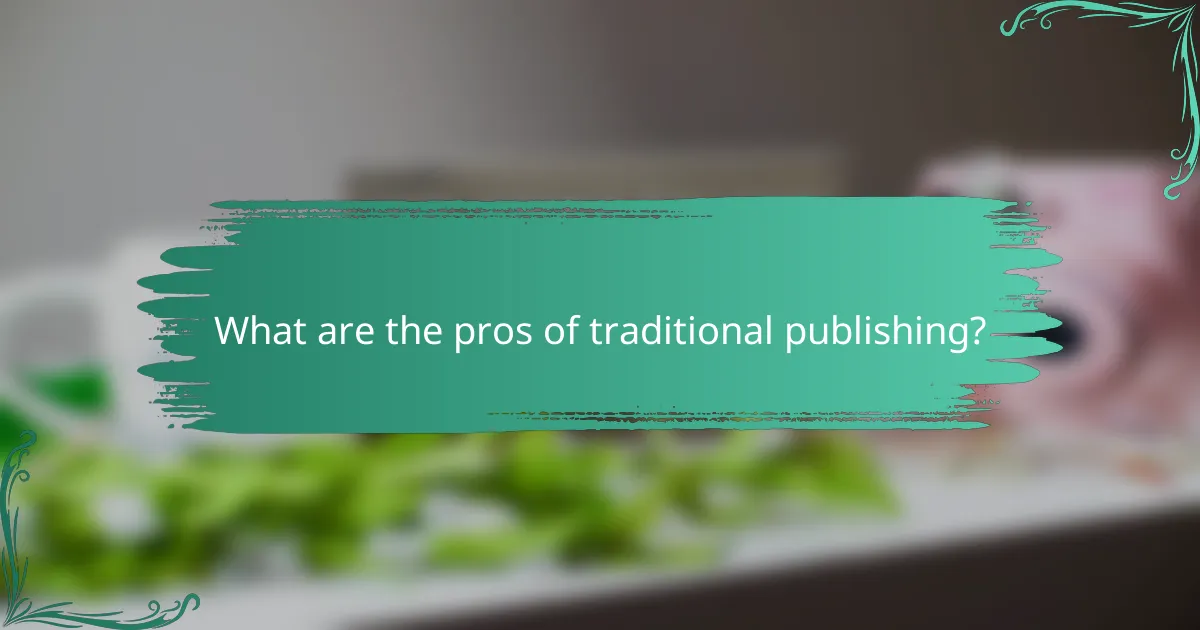
What are the pros of traditional publishing?
Traditional publishing offers several advantages, including established distribution networks, professional editing, and access to literary agents. These benefits can significantly enhance a book’s visibility and quality, making it a compelling option for many authors.
Established distribution channels
Traditional publishers have well-established distribution channels that can place books in major retailers, both online and in physical stores. This access can lead to higher sales volumes compared to self-publishing, where authors often struggle to reach a broad audience.
For example, a traditional publisher may have relationships with distributors and retailers that allow for prominent shelf placement and inclusion in promotional campaigns. This can be crucial for gaining visibility in a competitive market.
Professional editing and design
One of the key advantages of traditional publishing is the access to professional editing and design services. Publishers employ experienced editors who can refine a manuscript, ensuring it meets industry standards and resonates with readers.
Additionally, traditional publishers provide professional cover design and formatting, which can greatly enhance a book’s appeal. A well-designed cover can attract potential readers and contribute to better sales performance.
Access to literary agents
Traditional publishing often involves literary agents who can help authors navigate the publishing landscape. Agents have industry connections and can advocate for an author’s work, increasing the chances of securing a publishing deal.
Having an agent can also provide valuable insights into market trends and contract negotiations, which can be complex. This support can be particularly beneficial for new authors who may not be familiar with the intricacies of publishing contracts and rights management.
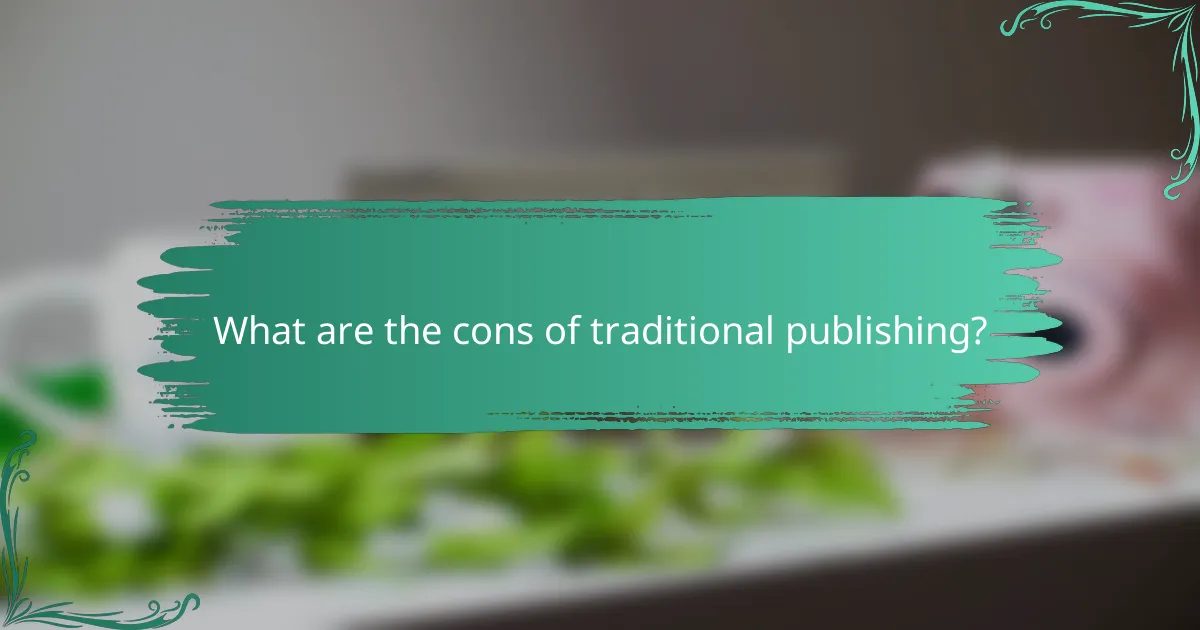
What are the cons of traditional publishing?
Traditional publishing has several drawbacks that authors should consider, including lower royalties, longer publication timelines, and less creative control. These factors can significantly impact an author’s experience and financial return.
Lower royalties
Authors typically receive lower royalties from traditional publishing compared to self-publishing. Standard royalty rates for print books often range from 5% to 15% of the cover price, depending on the publisher and format. This means that for a book priced at $20, an author might earn only $1 to $3 per sale.
In contrast, self-published authors can earn up to 70% of the sale price on platforms like Amazon. This significant difference can affect an author’s overall income, especially for bestsellers.
Longer publication timelines
Traditional publishing often involves lengthy timelines, sometimes taking a year or more from manuscript acceptance to book release. This process includes editing, design, marketing, and distribution, all of which can delay an author’s ability to reach readers.
In comparison, self-publishing allows authors to publish their work much faster, often within weeks. This speed can be advantageous for authors looking to capitalize on trends or timely topics.
Less creative control
Authors who choose traditional publishing may find that they have limited creative control over their work. Publishers often dictate aspects such as cover design, title, and even content changes, which can lead to frustration for authors who have a specific vision.
Self-publishing, on the other hand, grants authors full creative freedom. They can make decisions about every aspect of their book, from the cover art to the marketing strategy, allowing for a more personal touch and alignment with their artistic goals.
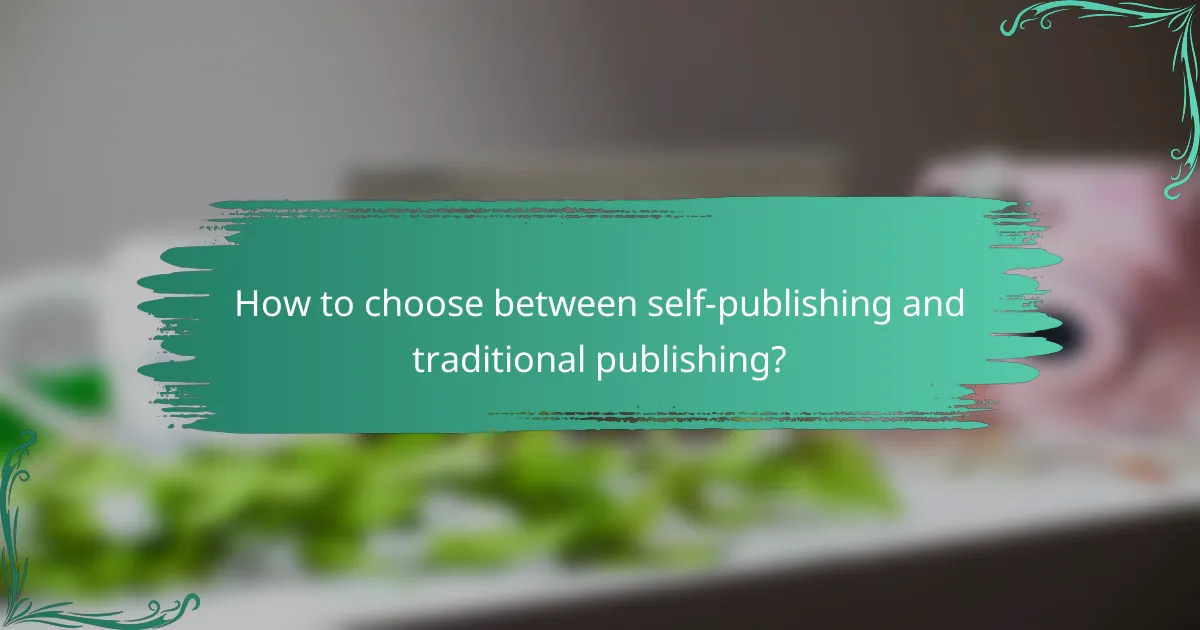
How to choose between self-publishing and traditional publishing?
Choosing between self-publishing and traditional publishing depends on your goals, budget, and target audience. Each option has distinct advantages and disadvantages that can significantly impact your publishing journey.
Assess your goals
Your publishing goals will greatly influence your choice. If you aim for creative control and faster publication, self-publishing might be the better route. Conversely, if you seek broader distribution and professional support, traditional publishing could align more with your objectives.
Consider what success looks like for you. Is it sales numbers, critical acclaim, or reaching a specific audience? Clarifying your goals will help you weigh the pros and cons of each publishing method effectively.
Evaluate your budget
Budget considerations are crucial when deciding between self-publishing and traditional publishing. Self-publishing often requires upfront investment for editing, cover design, and marketing, which can range from a few hundred to several thousand dollars. Traditional publishing usually covers these costs, but you may earn a smaller percentage of royalties.
Assess your financial situation and how much you are willing to invest in your book. If you have limited funds, traditional publishing may provide a safer route, while self-publishing could offer higher returns if you are willing to spend on quality production.
Consider your target audience
Your target audience plays a vital role in your publishing decision. Self-publishing allows you to cater directly to niche markets, as you can tailor your marketing strategies to specific reader demographics. Traditional publishers, however, have established distribution channels that can help reach a broader audience.
Research where your audience typically finds books. If they frequent independent bookstores or online platforms, self-publishing might be advantageous. If they rely on major retailers, traditional publishing could provide better visibility and access.
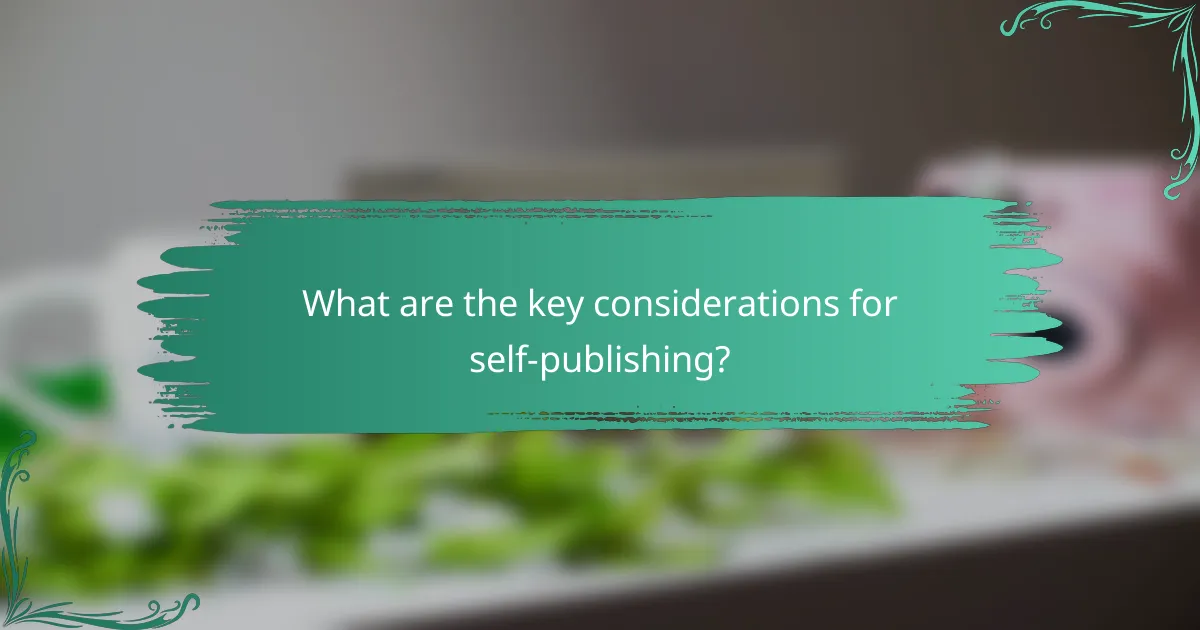
What are the key considerations for self-publishing?
Self-publishing offers authors greater control over their work but requires careful consideration of various factors. Key aspects include editing, cover design, marketing, and distribution, which can significantly impact the success of a self-published book.
Editing and proofreading
Editing and proofreading are crucial steps in self-publishing that ensure your manuscript is polished and professional. Consider hiring a professional editor to provide structural feedback and copyediting to enhance clarity and flow. Proofreading is the final step to catch any lingering typos or grammatical errors.
Budget for editing services, as costs can vary widely. Expect to pay anywhere from a few hundred to several thousand dollars depending on the length and complexity of your manuscript. Alternatively, consider joining a writers’ group for peer feedback, but remember that professional insights often yield better results.
Cover design
A compelling cover design is essential for attracting readers in a crowded market. Invest in a professional designer who understands genre conventions and can create a visually appealing cover that reflects your book’s content. A strong cover can significantly influence a reader’s decision to purchase your book.
When budgeting for cover design, costs can range from around $100 for basic designs to over $1,000 for high-quality custom artwork. Research and compare portfolios of different designers to find one that aligns with your vision and budget. Remember, a well-designed cover can enhance your book’s marketability and visibility.
